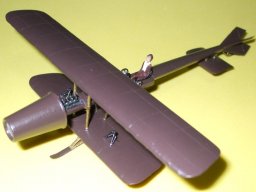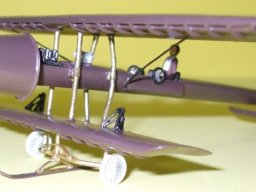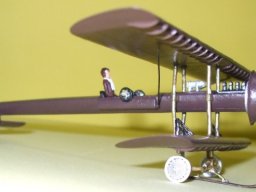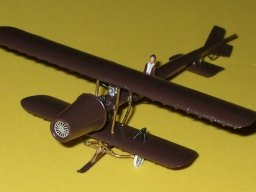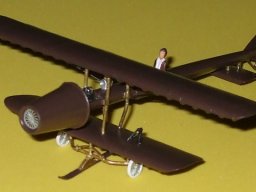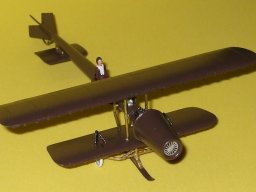Coanda-1910, Zane R. Nobbs, 1/72 IRMA Kit No. 3 Resin Kit
This kit is an International Resin Modellers Association initiative in resin with photo-etched parts, copper thread and metal details. Pilot added separately. In 1910 a young Rumanian by the name of Henri Marie Coanda built what some would consider the world’s first modern jet aircraft. It was not a turbojet by any means, but could be considered a motor-jet in that the turbine was driven by a conventional piston- engine. Mr. Coanda termed his engine a \"Coanda Air Reactive Unit\" coupled with a Clerget piston-engine. Some used the term \"Thermopropulsion Unit\" and in Popular Mechanics of March 1911 it was called a \"Suction Turbine\" because of the air intake method. Presented at the Paris International Aeronautic Salon in 1910 the aircraft has caused considerable debate since. The first dispute was which nation should get credit for the Coanda. In many books it was attributed to France, however, recent information has shown that Count Caproni of Italy helped in engine research as well as financing. The engine was apparently bench-tested in Taliedo, Italy, a suburb of Milan, before being attached to the airframe and sent by train to Paris. Later Mr. Coanda and Count Caproni would be in a legal dispute when the Campini-Caproni N.1 took to the air in 1940 because Mr. Coanda alledged that the Count’s engine was merely a variation of the original Coanda Air Reactive Unit. The courts sided with Count Caproni. The second dispute was whether the aircraft flew at all. It was said to have been secretly test flown by Mr. Coanda in Taliedo, Italy. The next flight was by accident, as supposedly stated by Mr. Coanda, at the Paris International Aeronautic Salon. Sources as far back as the late 1950s do confirm that Mr. Coanda did say that the aircraft flew a short distance, threw him clear, then burned up. However, the photograph in the March 1911 issue of Popular Mechanics is dated after the Paris Air Show had concluded which means that the aircraft still existed. One source, Flight Magazine, 29 October 1910, states that the Coanda 1910 had been purchased by a Mr. Weymann. While this would prove the aircraft had not crashed, it could also mean that it may be sitting somewhere in a barn or out-building long forgotten and waiting to be discovered like the Bugatti Model 100 racer recently was in Wisconsin! As you can see the aircraft consists of two wings, a large upper-wing over a smaller lower-wing. Note that there are no modern control surfaces? That is because on the first aircraft a technique called \"wing-warping\" was used. The wheels on either side of the cockpit were used to litterally bend the wings up and down, backward and forward, to steer the aircrft in the direction desired through a series of cables, wires and braces. This is one reason why the first aircraft were mostly wood and in most cases flexible. Another unusual feature for the Coanda 1910 is the tail-wing being braced separately from the fuselage. Mr. Coanda may have felt this lent to a more aerodynamic airframe. Yet another unusual feature is the arrangement of the four diagonally-opposed tail fins. Only the very ends were movable and were ahead of their time in that later jets would, in come cases, use tailess or \"V\" type tail configurations. With a minimal amount of struts, braces, wires and cables, the Coanda 1910 was a very elegant aircraft, especially for the beginning of the air age. It would be twenty-five years before the next jet-plane would be attempted with the Payen-Melot Pa-22/1R of 1935. There would be another attempt by Count Caproni in 1932 with his Stipa-Caproni which was actually a ducted-fan driven by a de Havilland Gipsy III Venturi piston-engine. Overall the Coanda 1910 was a dark wood color with metal fixtures. The fixtures could be aluminum, brass, steel, or a dull version of any of these. There was not too much color variation so most likely any paint scheme could be based on the 1/1 scale replica at the Coanda Airport in Romania. Also, it is most likely that the tires were white since cobalt black was not added to rubber in a standard format until after 1913 to make tires stronger. An additional use was found for the Coanda turbo-propulseur in the form of driving a snow-sled which the Grand Duke, Cyril Vladimirovich, of the Russian Empire found useful. It also brought additional publicity for Henri Coanda which he utlized to fund further research into his motorjets. -Zane R Nobbs© 2011

